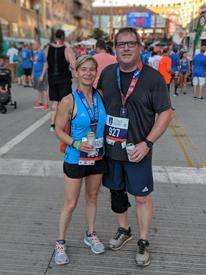We are pleased to announce that on March 4, 2025, an updated Rich Text Editor will be introduced in the MyFitnessPal Community. To learn more about the upcoming changes, please click here. We look forward to sharing this new feature with you!
Increasing Measured Cadence using Foot Pedometer

billscreen
Posts: 13 Member
I've been using a foot pedometer (linked to Garmin) for the majority of my runs this month and in the reports section of Garmin Connect, my Average Run Cadence reads: 160 spm (steps per minute). I'm planning to add cadence drills into upcoming workouts with the goal of reaching 185 spm over the next 4 months. Is this a reasonable goal if I consistently practice cadence drills for 15 minutes, 3 times a week ?
0
Replies
-
If you include your warmup and cool down during your runs, it would make sense that your average cadence is below your 185 goal.
Is your normal running cadence around 160 as well? If so, increasing to 185 spm that quickly may put you at risk of injury. I would recommend trying to increase your cadence slower and incrementally (maybe start with a target of 165-170spm) while doing intervals rather than doing 15 minutes at 185.. That's a pretty big jump if you're normally at 160spm.
HTH.0 -
Increasing your cadence is good practice if you're over striding but I don't know how much you should change and how long it should take to change or even if you should force it to change. I tend to look more at my average distance per stride rather than my cadence which changes depending on my pace.
Mine typically is in the mid 170s for easy runs and 180+ if I'm working harder. This was yesterday's workout.
https://connect.garmin.com/modern/activity/709639532
I never really do any cadence drills. I just generally think about it briefly while warming up. "Take short easy quicker steps". Mostly I tend to think about foot placement and having it land under my body. Cadence seems to just happen for me when I'm getting a good landing.
ETA: Fascinating! It's pretty obvious that I was having an easier and easier time finding the pace I wanted with each passing interval. I do know that the first one felt too choppy. The second one was better when I realized that I was over striding and needed to open up behind me more and hit mid-foot underneath me. I never really pay much attention to the cadence but that's cool to see.0 -
I struggle to understand the relationship between speed and cadence. Intuitively, I would think that cadence increases with speed, but for me, there is only a difference of about 2-4 spm between my 8 min mile and 9 min mile pace. I guess that means I increase my stride as I speed up. Coincidentally, my husband once said that I look like I take teeny steps when I run. I guess everyone is different in how they pick up their speed. I quit trying to worry about it.0
-
My cadence seems pretty similar at easy pace and at faster paces (I don't measure it normally, but whenever I count it is always 188). This means that when I run very slowly, it looks very very bouncy, like I am jumping up and down on the spot. I don't know enough about it as that's just how I run naturally, but I would be a bit wary of trying to change something about your natural running style too quickly. If you are overstriding and tending to injure yourself, maybe it needs fixing, but otherwise you might cause problems you don't currently have.0
-
I fall into the camp of "why fix what isn't broken?" My cadence is almost always between 160 and 165, no matter if I'm pacing 8:10 or 9:30. Why try to boost your cadence 25 steps per minute? Will this actually make you run faster, or will you just be taking more steps?0
-
Another in the "Why fix what isn't broken" camp. If everything is going well with your running, leave the cadence alone. If you're over striding big time, then it could be something to look at otherwise you actually risk an injury as you attempt to change your biomechanics.0
-
@CodeMonkey78 - good question - my cadence does increase when I'm doing a speed workout, but in general it's between 160 spm and 165 spm for most of my runs.
@_Waffle_ - thanks for sharing your stats. I've had friends take video of me while running and it looks like I am just slightly over-striding. I typically land with a mid-foot strike. My average distance per stride is between 1.31m and 1.41m (my height is 6'2)
I'm not an expert on cadence, but from what I've read, many recreational runners have room for improvement when it comes to optimizing their running economy. There are some conflicting expert opinions on what a runner's optimal cadence should be, but it seems that many coaches agree that between 175 spm and 185 spm is an optimal stride rate.0 -
If your cadence is in the 160s, I'd bet you don't have proper form. Will this injure you? Probably not. Will it affect your performance and efficiency? Yep. Tall people have a lower cadence though, in my experience.0
-
SonicDeathMonkey80 wrote: »If your cadence is in the 160s, I'd bet you don't have proper form. Will this injure you? Probably not. Will it affect your performance and efficiency? Yep. Tall people have a lower cadence though, in my experience.
I sure as heck didn't have great form when my cadence was 150spm.
I've been increasing my cadence since September, I'm still not at 180 but I'm damn near close and I've been averaging 170-176 for months now. Sometimes I hit the 180.
It's helping my ankle issues but it's a lot of work to fix cadence. It was physically exhausting and mentally painful - I started with an app that figured out my cadence. It'd essentially yell at me if I was too slow... And that ended up with me crying once or twice.
I just think 4 months isn't a lot of time to increase that much... *shrugs* what do I know though? I'm constantly asking Dough, Josee, et al for advice lol
My cadence is a little faster with speed but not by much.0 -
I read somewhere that runners naturally develop a more efficient stride (hence cadence) over time. I suppose it's something to be mindful of, but I agree with Lishie that if you try too hard to force it, it will drive you mad and take the joy out of running.
I also think Doug is right that taller people probably tend to have a lower cadence. I am only 5 ft tall and my normal cadence is around 192.0 -
I'm 5'7" but have long-ish legs for my height - 35/36" inseam and I'm hitting 170-176.lporter229 wrote: »
I also think Doug is right that taller people probably tend to have a lower cadence. I am only 5 ft tall and my normal cadence is around 192.
I ran with an older gentleman last night with our group and he's about my height but long torso, he had a pretty quick cadence going from the sound of his feet lol
0 -
I always wonder with these reports on what is optimal, especially when the conclusions are based on what elite runners do, whether the elite runners are elite partly because they naturally have the biomechanics that allow them to do the optimal thing (whether it's footstrike, cadence, whatever) or whether anyone can learn or should learn those things.
I'm not remotely elite, I am an above-averagely-good-but-not-outstanding female club runner, and I am lucky enough to naturally run in a style which is considered desirable (midfoot strike, high cadence). I am not prone to overuse injuries. But I think maybe that just means I'm lucky - I've heard so many stories about people who don't naturally have those running qualities who get along just fine until they try to change something and then end up injured. And I also know plenty of runners who don't have ideal form, cadence etc. but are better runners than I am.0 -
PS: I'm also quite short.
 0
0 -
I always wonder with these reports on what is optimal, especially when the conclusions are based on what elite runners do, whether the elite runners are elite partly because they naturally have the biomechanics that allow them to do the optimal thing (whether it's footstrike, cadence, whatever) or whether anyone can learn or should learn those things.
I am in this camp as well. What is applicable to elite runners may not apply to a recreational runner. The change in cadence with speed seems to vary a good bit between runners, even elites, as well. Some build speed more with stride length, others with step rate.
I focus on not overstriding and having my foot land under me, but not on cadence specifically. I have read several studies that show making a small deliberate increase in cadence helps correct overstriding.0 -
What I found was that consciously increasing my cadence forced a shorter pace, and more efficient form by encouraging that "just in front of centre of mass" footstrike. I'm on about 160 to 165 at the moment. I'm a reasonable height with long legs so suspect I'll need some focussed effort to improve that.
What I have found is that my lower legs are much fresher now, although as I've really only been running consistently for 2 years I couldn't attribute that to the cadence issue.
What I have found is that when I've tried HR based LSR, or even recovery pace runs at less than 6 min/ km my cadence ends up lowering, so I get bouncy and inefficient, probably countering the benefits of the run to my greater objectives.0 -
@billscreen. . . you can certainly increase your stride rate. Can you increase it to 185 I doubt it. I would like you to prove this wrong though.
I believe Daniels studied Olympians in the 80's and this lead to the 180 number. I think the years of study and coaching he only had one runner under, and she was in the mid 170's. We are talking about elite runners. Recreational runners stride rate is somewhere between 150-170, I think.
One of the reasons stride rate is viewed is in part tied with the technology we wear. Do I look down at my stride rate periodically(yes) from my Garmin and I am typically more tired when I increase my rate over the same distance then when I slow it down. Is there something wrong with a runner's form if they have a low cadence. . . probably. For me, a weak core and not stretching lead to form falling apart usually at a mile marker about 80% past a normal distance. Normal distance for me is 4 miles, for many they may never experience this. So, more core work, stretching pre and post, slower and longer runs, lead to improved form and if my cadence pops up. . .super.0 -
Thanks all.0
-
Proof that cadence isn't everything. This morning's run included 8 miles @ HMP. It took me a couple miles to get the pace nailed down the point that I didn't have to keep looking at the watch. The first few miles had some points over 190 and it didn't feel comfortable. I opened up the stride length a bit instead of keeping the cadence that high and then it felt really good.
Obviously there's a balance between meters per stride and stride rate. I never look at the cadence during a run. I just go off of what feels good. Keep the cadence up of course but at some point it's better to just take longer strides.
https://connect.garmin.com/modern/activity/7161202540 -
I've been trying to increase mine over my natural 160-ish avg and can only get up to 168. I do have long legs (32" inseam) and have had a long stride since grade school as I remember my track and field coach mentioning it; it was good for hurdles. My most recent coach was trying to get me around 180 and I've worked for almost four months at it with no real improvement. I am barely a jogger (very slow currently), and thought maybe it would increase if I got faster, but . . . maybe I will stop worrying about it. I much prefer the feel of my natural stride. Appreciate all the info/experiences here!0
-
Yes, it's certainly a challenge. I'm going to keep practicing and set my first target at 170. Last week, I ran with my guitar metronome and tried doing drills at 180 spm for 20 mins (at a very slow pace), and I'm definitely NOT there yet (calves were sore for 3 days - LOL). I must admit though I can see how doing these drills can improve overall running form and economy - I felt really light on my feet and my arm swing was more compact and rhythmic.
Here's some articles I found useful (..after I was sore ):
):
http://www.runfartherandfaster.com/news/cadence-drill
http://adventure.howstuffworks.com/outdoor-activities/running/training/turnover-drills.htm
0 -
Wanted to pass along a good read on this topic:
evolutionrunning.com/docs/Evolution-Running-Turnover-for-Slow-Running.pdf
0 -
billscreen wrote: »Wanted to pass along a good read on this topic:
evolutionrunning.com/docs/Evolution-Running-Turnover-for-Slow-Running.pdf
Thanks for sharing this. I can run intentionally fast paces at or near this 180 step per minute turnover rate and as I've gotten better at it, I have gotten faster. However, I haven't tried to run easier runs at this turnover rate which calls for really short strides. Instead, it has been this slower turnover pace as mentioned in this article.
Today, I ran one of my easier runs at this high turnover rate by shortening the stride to maintain a low heart rate (even shorter on hills) with very little bounce. It was on one of several courses I run as an easy run with only short hill climbs (or drops). Since I run by time and (heart) pace, my timer is set in five minute increments rather than distance. So, by recent experience, I know where I usually end up at each time increment by controlling against heart rate.
So, I was really surprised by how much farther I was going in each five minute increment while keeping my heart rate down. Even as the course tilted up slightly and not so slightly, I was cruising along at a pace at least 30 seconds per mile faster than my "standard turnover pace" associated with this lower heart rate. I would typically run between 4.4 and 4.5 miles during the 45 minute out and back run. Today, I ran 4.85 miles and my average heart rate was actually lower by 3-4 bpm.
In reading the article, I may have been doing these easier runs incorrectly all this time. I'm coming up on my last marathon for the spring in three weeks, so I'm not sure how much of this I can incorporate into this upcoming race. But it will give me something to work on with my metronome over the summer and for shorter races that may be in my future.0
This discussion has been closed.












